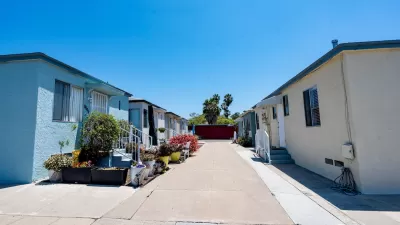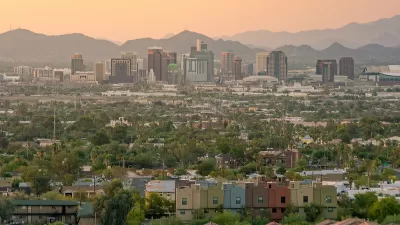After the passage of a contentious zoning reform law that encourages ‘light infill’ in single-family neighborhoods, few California households have submitted applications to build extra units, largely due to onerous restrictions imposed by local laws.

A recent California law aimed at boosting housing construction by easing the process for building additional units caused major backlash as critics worried about the ‘death of single-family neighborhoods’ and loss of local control. However, since its passage, few property owners have applied for permits under the law.
As Dustin Gardiner reports in a paywalled article in the San Francisco Chronicle, “Under SB9, homeowners with large enough lots are supposed to have an expedited path to build more units on their property by either splitting their lot and building another home or converting their home into a duplex — or both.” But as one Bay Area family found out, the process still includes onerous fees (in the case of their 1,500 square foot proposed project, $95,832) that prohibit homeowners from moving forward with their plans. “The fee, ostensibly to help pay for new parks, is the same amount that Sunnyvale charges developers to build a new seven-home subdivision.” In this case, the family secured a permit for a smaller ADU with no fee.
“The case is an example of how housing advocates say SB9, which aims to address the state’s dire housing shortage by allowing more density in neighborhoods zoned for single-family homes, has been hamstrung in its impact.” According to Gardiner, “In San Francisco, 14 property owners have applied to build SB9 projects, all of which are still being reviewed by the Planning Department.” To date, “The Chronicle couldn’t find an example of a project that has broken ground in the Bay Area.”
Planetizen has previously covered some of the ‘creative’ measures cities have attempted to take to block SB9 development. “YIMBY Law is tracking at least 80 cities that have adopted — or are considering — policies that it deems hostile to the law, from San Francisco to Sunnyvale. It has asked Bonta to investigate around 50 cities that it says are out of compliance.”
“Annie Fryman, a former legislative adviser on housing policy who now works for a company that builds ADUs, said SB9 needs to be revised to remove the ability cities have to impose exorbitant fees and create dubious historic districts to block construction.” Fryman also recommends changing the law to require that cities review permits within a reasonable time frame and calls on the state to provide support and resources to homeowners who don’t have the same expertise in housing construction as developers do.
FULL STORY: Despite uproar, few seek to use California’s new housing-density law. What’s stopping them?

Alabama: Trump Terminates Settlements for Black Communities Harmed By Raw Sewage
Trump deemed the landmark civil rights agreement “illegal DEI and environmental justice policy.”

Planetizen Federal Action Tracker
A weekly monitor of how Trump’s orders and actions are impacting planners and planning in America.

Why Should We Subsidize Public Transportation?
Many public transit agencies face financial stress due to rising costs, declining fare revenue, and declining subsidies. Transit advocates must provide a strong business case for increasing public transit funding.

Understanding Road Diets
An explainer from Momentum highlights the advantages of reducing vehicle lanes in favor of more bike, transit, and pedestrian infrastructure.

New California Law Regulates Warehouse Pollution
A new law tightens building and emissions regulations for large distribution warehouses to mitigate air pollution and traffic in surrounding communities.

Phoenix Announces Opening Date for Light Rail Extension
The South Central extension will connect South Phoenix to downtown and other major hubs starting on June 7.
Urban Design for Planners 1: Software Tools
This six-course series explores essential urban design concepts using open source software and equips planners with the tools they need to participate fully in the urban design process.
Planning for Universal Design
Learn the tools for implementing Universal Design in planning regulations.
Caltrans
Smith Gee Studio
Institute for Housing and Urban Development Studies (IHS)
City of Grandview
Harvard GSD Executive Education
Toledo-Lucas County Plan Commissions
Salt Lake City
NYU Wagner Graduate School of Public Service





























